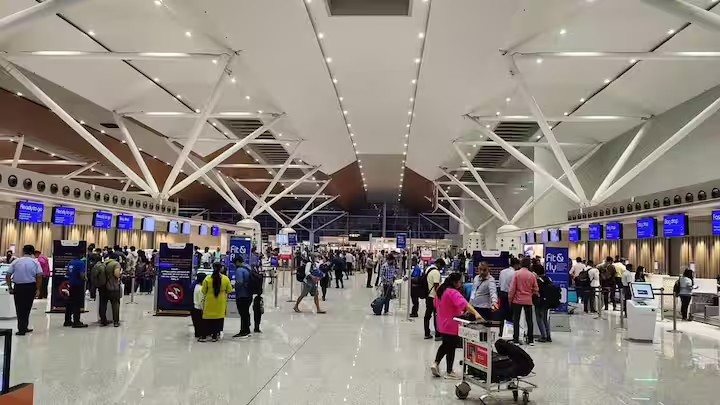The AI-driven airside operations management system has emerged as a groundbreaking solution in contemporary airport management.
As airside operations grow increasingly complex, the need for automation and real-time tracking has become vital for ensuring efficiency, safety, and transparency.
In response to this demand, Delhi International Airport Limited (DIAL) has introduced the Unified Total Airside Management (UTAM) system, an innovative AI-powered solution aimed at optimizing airside operations.
What is UTAM? A Technological Achievement
In partnership with WAISL, DIAL has created UTAM to improve real-time monitoring and operational effectiveness.
This AI-driven airside operations management system consolidates data from various sources, facilitating seamless collaboration among stakeholders, including airlines, ground handlers, and security teams.
By utilizing advanced technologies such as Artificial Intelligence (AI), Machine Learning (ML), the Internet of Things (IoT), and radar systems, UTAM enhances airside management while upholding the highest standards of safety and service quality.
Key Features of UTAM
-
Real-Time Tracking and Monitoring
A primary benefit of UTAM is its capability to monitor all airside vehicles in real time. This includes:
- Luggage carts
- Fuel trucks
- Maintenance vehicles
By providing live updates on vehicle movements, UTAM enhances logistics efficiency, alleviates congestion, and accelerates turnaround times.
-
Geofencing for Ground Service Equipment (GSE)
UTAM tracks the entry and exit times of GSE within designated geofenced areas, ensuring adherence to service-level agreements.
Any discrepancies from the expected turnaround times prompt automatic notifications, facilitating timely corrective measures.
-
Mile View Monitoring (10-40-70 Mile Radius)
Another significant feature of UTAM is its provision of a multi-layered real-time perspective on aircraft movements at varying distances:
- 10-mile view: Immediate airside operations
- 40-mile view: Incoming aircraft
- 70-mile view: Comprehensive airspace oversight
This functionality enhances readiness and bolsters decision-making processes, ensuring effective aircraft coordination.
-
Flight Hovering Monitoring
In partnership with Air Traffic Control (ATC), UTAM monitors aircraft that are hovering in the airspace and identifies the reasons for delays.
This information aids in reducing inefficiencies and promotes smoother operational flow.
-
On Block/Off Block Time Records
UTAM automatically logs On Block and Off Block times for non-VDGS (Visual Docking Guidance System) parking positions.
This guarantees precise billing, accurate reporting, and improved operational efficiency.
-
Parking Stand Utilization
By overseeing the utilization of parking stands, UTAM optimizes space distribution and resource management.
This reduces idle time and enhances overall airside operational efficiency.
-
Baggage Delivery Efficiency
By tracking baggage trolleys in real time, UTAM ensures that an adequate number of trolleys are positioned at the appropriate locations.
This boosts baggage handling efficiency and improves the overall passenger experience.
-
Management of Taxiways and Runways
Effective management of taxiways and runways is essential for reducing delays and enhancing airport operations. UTAM offers:
- Tracking of runway occupancy
- Monitoring of taxiing durations
- Optimization of taxiway assignments
These functionalities facilitate improved Collaborative Decision-Making (CDM) and enhance the efficiency of the Airport Operations Control Center (APOC).
Enhancing Safety and Security
Prioritizing safety and security within airport facilities is critical. By utilizing AI-driven surveillance and monitoring systems, UTAM significantly mitigates risks and bolsters operational oversight.
Through real-time data analytics, potential threats can be detected and addressed proactively, fostering a safer environment for both passengers and personnel.
Monitoring Vehicle Speed
UTAM tracks the speed of all vehicles operating on the airside to ensure adherence to safety standards. Alerts are generated when vehicles exceed established speed limits, thereby helping to avert accidents.
Monitoring Vehicle Paths
With real-time tracking capabilities, UTAM ensures that vehicles adhere to designated routes, minimizing the likelihood of collisions and unauthorized movements in the airside area.
Monitoring Baggage Trolleys
By closely monitoring baggage trolleys, UTAM alleviates congestion and ensures efficient allocation, thereby reducing delays in baggage delivery.
Management of Airside Space
Effective management of airside space is vital for avoiding bottlenecks. UTAM optimizes the movement of aircraft, vehicles, and ground staff, ensuring seamless operations.
Playback Feature for Incident Analysis
The playback feature of UTAM enables operators to review historical movements of vehicles and aircraft, assisting in incident analysis and informing future operational enhancements.
The Advancement of AI-Driven Airside Operations Management System
The effective deployment of UTAM at Delhi International Airport represents a pivotal advancement in the realm of AI-enhanced airside operations.
By utilizing artificial intelligence and machine learning, the airport is equipped to forecast possible delays, streamline resource allocation, and improve overall operational efficiency.

The incorporation of cutting-edge technologies is set to transform airport management, fostering operations that are both environmentally sustainable and more accommodating for passengers.
Moreover, AI-driven systems such as UTAM will facilitate more informed decision-making, thereby minimizing human error and bolstering safety measures.
Through ongoing data analysis and predictive insights, airports can proactively address operational issues before they manifest.
In the long term, AI-enhanced airside management is poised to not only boost efficiency but also promote environmentally responsible practices.
By reducing fuel consumption through optimized taxiing and vehicle operations, airports can significantly lessen their carbon emissions.
As an increasing number of airports embrace similar AI-driven initiatives, the aviation sector is likely to experience a profound transition towards more intelligent and eco-conscious operations.
Expert Editorial Comment
To conclude, the AI-driven airside operations management system implemented at Delhi International Airport signifies a significant leap forward in aviation technology.
By leveraging artificial intelligence, machine learning, and the Internet of Things, UTAM improves efficiency, transparency, and safety in airside operations.
Its capabilities for real-time monitoring and predictive analytics position UTAM to transform airside management, establishing a new standard for airports globally.

